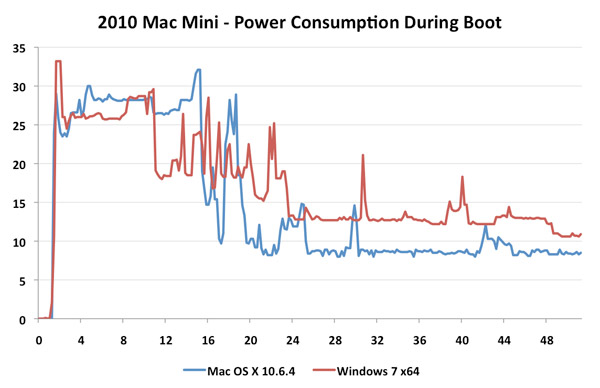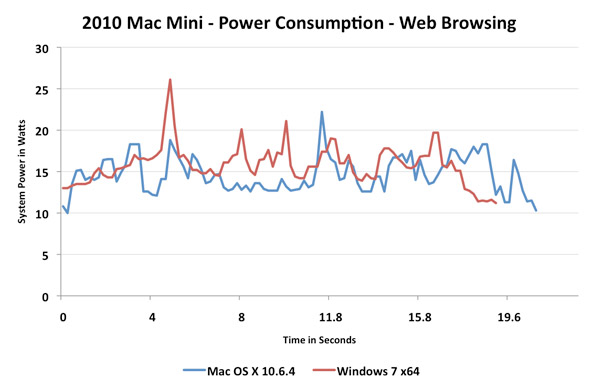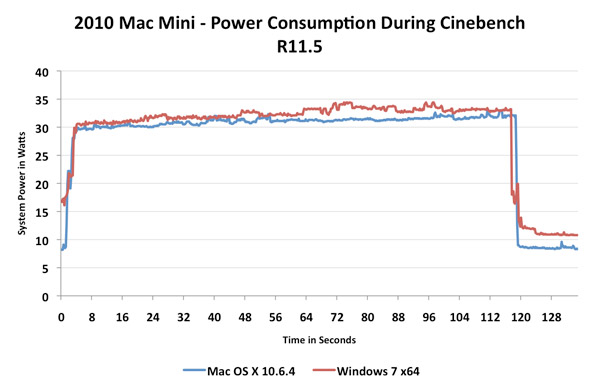Apple Mac mini Review (Mid 2010)
by Anand Lal Shimpi on August 9, 2010 3:37 AM ESTHonest Apple & Energy Efficiency
Apple calls the new Mac mini the world’s most energy-efficient desktop computer. I thought that might be a bit of a stretch but if you look at the numbers, they’re very convincing.
Zotac’s HD-ID11, an Atom based next-generation ION nettop, idles at 21.7W. Even the ASUS UL50V notebook, with a Core 2 Duo SU7300 (1.3GHz) ultra low voltage notebook CPU idles at 8.1W with the screen disabled.
Now that 8.1W number is unrealistic for a notebook. The screen was disabled, battery removed, WiFi disconnected and no ethernet cables plugged in. If I run the 2010 Mac mini in a similar configuration (minus the display/battery part since, well, they don’t exist), the entire system consumes 7.5W at idle.
Connect to a WiFi network, plug in an Ethernet cable and you’re looking at 8W. I have not seen a modern desktop machine idle at lower power than the 2010 Mac mini.
| 2010 Mac mini Power Usage | ||||||||
| Idle | Half Life 2 Episode Two | DVD Playback | Web Browsing | Quicktime Encode | Cinebench R11.5 | |||
| Apple Mac mini (Mid 2010) | 8.0W | 26.4W | 16.1W | 8.6W - 19W | 30.3W | 30.0W | ||
Part of this has to do with Apple’s very efficient integrated PSU. Unlike the other two systems I mentioned here, the mini uses a custom, integrated 85W PSU specifically designed for the system’s load.
Part of it has to do with Apple’s component selection. The mini is built entirely out of notebook parts with a custom motherboard design devoid of anything unnecessary. I’ve even heard that Apple goes to great lengths to ensure the CPUs/GPUs/chipsets it gets are on the lower power portion of the yield curve for products like the mini or MacBook Air.
The third explanation for why Apple is able to make such a bold claim about the Mac mini’s power consumption has nothing to do with hardware at all. As we’ve shown in the past, Mac OS X tends to offer better battery life than Windows in situations where the system sees a lot of idle time. Reading web pages, typing a document, etc... all tend to expose this advantage. Under load however, the OS X power advantage disappears - we are after all dealing with the same components regardless of OS.
The idle battery life advantage comes from lower idle power, presumably through heavy OS and hardware optimization. While I measured 8W at idle under OS X, running Windows 7 (power saver mode) on the Mac mini resulted in a 12W idle power without any changes to the hardware. Granted I don’t have identical hardware by another manufacturer to confirm that this isn’t negligence on Apple’s part to optimize its firmware for Windows 7. However in the past we’ve shown that systems from Lenovo, despite having similar specifications to Apple notebooks deliver worse idle battery life. I believe it’s safe to assume that part of the reason Apple is able to make such a bold claim about the mini’s energy efficiency is because it is the only desktop that can be sold running Mac OS X.
I recorded the mini’s power consumption over time running both OS X 10.6.4 and Windows 7 x64 to give you an idea of where the power consumption differences come into play.
This first chart shows power consumption during the boot process. From power on until you get a cursor at the desktop and the system’s power draw stabilizes for a while. The red line is Windows 7, the blue line is OS X:

Peak power consumption is nearly identical between the two OSes during the boot process. However, OS X drops down to idle sooner (finishes booting quicker) and remains at a lower idle point than Windows 7. Both OSes experience blips of activity after we reach the desktop as additional services are started.
The next test is some basic web browsing using Chrome. I loaded the AnandTech front page, scrolled to an article, clicked on it, scrolled down to the comments and recorded system power consumption:

I tried to get both runs as close as possible to one another, but I am human. Even while browsing the web the CPU has ample time to go into lower power states. Total platform power dips lower under OS X and is lower overall.
Our final test shows a run of Cinebench R11.5. The legend is the same, red for Windows, blue for OS X, but this time the CPU is pegged at 100% for the duration of the test:

The two systems are nearly identical in terms of power consumption. OS X still offers a slight advantage that’s consistent but not pronounced. The render completes in approximately the same amount of time in both OSes, although Windows is a hair quicker. The mini under OS X scored 1.38 points vs. 1.39 under Windows 7.
Since there is a performance difference here, it could just be that Apple is optimizing for power consumption rather than peak performance in the OS itself. It’s difficult to analyze but it’s something I am seeing fairly consistently.










93 Comments
View All Comments
Guspaz - Monday, August 9, 2010 - link
Ever since the "Intel HD" integrated graphics (the ones that are on-package for certain i3/5/7 models) came out, Intel has had passable integrated graphics. They perform on-par with the GeForce 9400M (which was benchmarked in this review). That's not saying much, but it's an enormous improvement over the previous generation of GMA. That 9400M as benchmarked, though, is from a year ago (mid 2009), so I can't argue that Intel has caught up enough with nVidia to be a viable alternative for Apple. If they keep up the current momentum, though, they'll probably catch up with nVidia soon enough.From a more anecdotal perspective, I recently bought a Toshiba Portégé r700 (Anandtech recently discussed it in their "under 14" article) which (for my model) features a Core i5 520M. The graphics are Intel's on-package.
Performance is acceptable. StarCraft 2 is playable at native resolution with a perfectly smooth framerate, but this is admittedly at low to low-medium settings. That's more than I expected to get out of it, though; I didn't buy this thing for gaming, so anything at all is a bonus.
thunng8 - Tuesday, August 10, 2010 - link
9400M graphics was first released October 2008, not mid 2009. Also, the Integrated graphics used in the i3 mobile is clocked significantly lower than the i5 desktop. Only on the i5 that the Intel integrated graphics almost matches the 2008 9400M.Stuka87 - Monday, August 9, 2010 - link
I would have loved to see how it compared to the previous Mac Mini's with the intel graphics and such.And like some others have asked, will it run Starcraft 2? I typically play on my PC, but would be nice to not have to switch some times (Since saved games are saved on b.net).
archer75 - Monday, August 9, 2010 - link
I'm curious to know how World of Warcraft performs at 1900x1200 with all in game settings maxed?icecreampop3 - Monday, August 9, 2010 - link
At 1280x1024, maxed, 23fps according to notebookcheck.net. I'd say maybe 18 fps @ 1080p.archer75 - Monday, August 9, 2010 - link
I just looked up some youtube videos of wow running on the mini at 1920x1080, slightly lower than my resolution of 1920x1200 but they were getting 18-25fps in cities and warsong. So not that great.james.jwb - Monday, August 9, 2010 - link
Not only a WOW player, but you want a Mac Mini?You must be one tough SOB to admit to this ;)
tipoo - Monday, August 9, 2010 - link
I'm really confounded by the price jump over the previous generation. If it had stayed the same, I may have found the Mini to be worth it.mados123 - Monday, August 9, 2010 - link
A better alternative for an HTPC would be the Viewsonic VOT550 w/ Blu-ray, Core 2 Duo 2,2GHz, 4GB, etc. for around $600.http://www.viewsonic.com/vot530-550
Claudius-07 - Monday, August 9, 2010 - link
Just got an Acer Revo and installed XBMC. I have a seagate T+, HDX 1000, WD Live, and the Revo+XBMC is the best thing thus far (however can't bitstream HD audio). Anyhow, love Apple but still scratching my head on this one for the price.